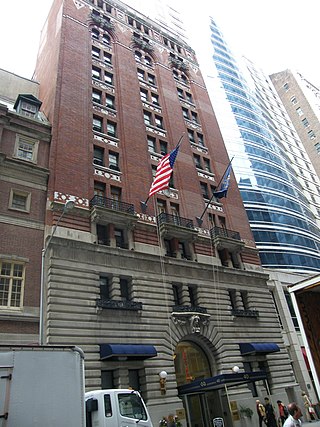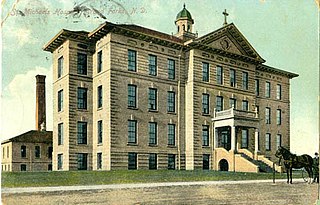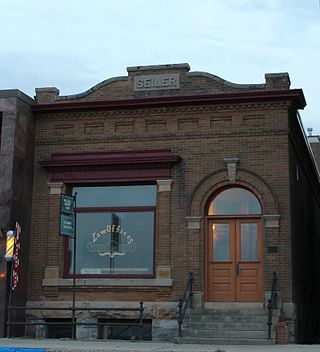
List of the National Register of Historic Places listings in Franklin County, New York

The U.S. National Register of Historic Places (NRHP) classifies its listings by various types of properties. Listed properties generally fall into one of five categories, though there are special considerations for other types of properties which do not fit into these five broad categories or fit into more specialized subcategories. The five general categories for NRHP properties are: building, district, object, site, and structure.

Grand Canyon Village Historic District comprises the historic center of Grand Canyon Village, on the South Rim of the Grand Canyon in Grand Canyon National Park, Arizona. The district includes numerous landmark park structures, many of which are National Historic Landmarks themselves, or are listed on the National Register of Historic Places. The town design as a whole is also significant for its attention to integration with the Grand Canyon landscape, its incorporation of National Park Service Rustic design elements, and for the idiosyncratic design of park concessioner structures such as the El Tovar Hotel.

Rim Village is the main area for tourist services in Crater Lake National Park in southern Oregon, United States. It is located on the southwest rim of the caldera overlooking Crater Lake. The National Park Service designed Rim Village to concentrate park services at a location that provided easy access to rim trails and view points. Because of the unique rustic architecture of the Rim Village structures and the surrounding park landscape, the area was listed as Rim Village Historic District on the National Register of Historic Places in 1997.

Comfort Station No. 72 is a historic visitor services building in Crater Lake National Park in southern Oregon, United States. It was built in 1930 to provide a public toilet and shower facilities for park visitors. It was constructed in the National Park Service Rustic style of architecture, and was listed on the National Register of Historic Places in 1988.

The Whitney Avenue Historic District is a historic district in the East Rock neighborhood of New Haven, Connecticut. It is a 203-acre (82 ha) district which included 1,084 contributing buildings when it was listed on the National Register of Historic Places in 1989.

This is a list of the National Register of Historic Places listings in Franklin County, Virginia.

The Forster Hotel, built in 1870 and expanded in 1913, is a property on the National Register of Historic Places in Mendon, Utah, United States. It was listed on the National Register in 2008 for its historical and architectural qualities.

The Webster Hotel is located in New York City. The building was built in 1902 and was added to the National Register of Historic Places on September 7, 1984. It was designed by the architectural firm of Tracy and Swartwout, and built in the Classical Revival style.

The Franklin County Courthouse is a courthouse located in Farmington, Maine, the county seat of Franklin County. The 1885 courthouse represents a sophisticated design by George M. Coombs, with an addition in 1917 by Coombs' son, Harry Coombs. The building, the county's first purpose-built courthouse, was listed on the National Register of Historic Places in 1983.

George Hancock was an architect active in North Dakota, Montana and Minnesota.

Grace Episcopal Church is an historic Episcopal church building located at 405 2nd Avenue, North East, in Jamestown, Stutsman County, North Dakota. Designed in the Late Gothic Revival style of architecture by British-born Fargo architect George Hancock, it was built 1884 of local fieldstone exterior walls and a wooden roof. Early parish records contain several assertions that George Hancock modeled the church after Christ Episcopal Church which had been opened in 1881, but if he did, it was only in a very general, not specific way. Hancock's later work St. Stephen's Episcopal Church is much more closely related to Christ Church, Medway. On December 3, 1992, Grace Episcopal Church was added to the National Register of Historic Places.

Tulipwood is a shingle style historic home at 1165 Hamilton Street in the Somerset section of Franklin Township, Somerset County, New Jersey, United States. It was designed by Jacob August Lienau.
The Jamestown Historic District in Jamestown, North Dakota is a 43.1-acre (17.4 ha) historic district that was listed on the National Register of Historic Places (NRHP) in 1989. It includes works designed by the Hancock Brothers and by Gilbert Horton. It includes Chicago style architecture, Italianate architecture, Early Commercial architecture, and other architecture. The listing included 104 contributing buildings.

The Seiler Building on First St. E. in Jamestown, North Dakota was built in 1904. It was designed by George & Walter Hancock.

The Hightower Building is a historic commercial office building located at 105 North Hudson in Oklahoma City, Oklahoma.

Charles E. Hartge was an American architect who was born in Hamburg, Germany as Carl Emil Hartge. His work still stands today in North Carolina.

The Winnemucca Grammar School, located at 522 Lay St. in Winnemucca, Nevada, is a historic school that was designed by architect Richard Watkins in Prairie School style. It was built during 1927–28. It was listed on the National Register of Historic Places in 1991.
The Continental Oil Company Filling Station at 35 First Ave. N. in Kalispell, Montana was a historic filling station built around 1932 for the Continental Oil Company which was listed on the National Register of Historic Places in 1994. It has since been demolished.




















